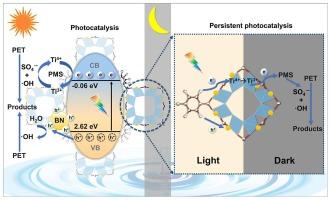当前位置:
X-MOL 学术
›
Chem. Eng. J.
›
论文详情
Our official English website, www.x-mol.net, welcomes your
feedback! (Note: you will need to create a separate account there.)
MIL-125-NH2/BNQDs persistent photocatalyst enhanced peroxymonosulfate activation for efficient PET plastics removal
Chemical Engineering Journal ( IF 13.3 ) Pub Date : 2024-11-19 , DOI: 10.1016/j.cej.2024.157764 Xiaran Su, Yuming Dong, Yongfa Zhu, Haifeng Shi
Chemical Engineering Journal ( IF 13.3 ) Pub Date : 2024-11-19 , DOI: 10.1016/j.cej.2024.157764 Xiaran Su, Yuming Dong, Yongfa Zhu, Haifeng Shi

|
Polyethylene terephthalate plastic is widely used and poses challenges in degradation, highlighting the importance of finding efficient degradation methods. In this study, MIL-125-NH2/BNQDs composites were synthesized to degrade polyethylene terephthalate plastic in the peroxymonosulfate-activated persistent photocatalysis system. The results showed that MIL-125-NH2/2BNQDs exhibited the best degradation effect on polyethylene terephthalate plastic activated by peroxymonosulfate under light conditions, with a degradation efficiency of 95.71 % achieved by adding 3 mM peroxymonosulfate, which was 3.01 times that of MIL-125-NH2 alone. Furthermore, all composite samples retained persistent catalytic activity under dark conditions after light irradiation. After visible light irradiation, the polyethylene terephthalate degradation efficiency achieved 90.23 % when MIL-125-NH2/2BNQDs activated by peroxymonosulfate were used under dark conditions. The mechanism of action of reactive radicals in the polyethylene terephthalate degradation process was revealed by scavenger experiments. In-situ X-ray photoelectron spectroscopy analysis demonstrated that MIL-125-NH2/2BNQDs induce Ti4+ to Ti3+ transition through electron transfer, resulting in higher efficiency of peroxymonosulfate activation. The composites achieve improved electron storage capacity and enhanced peroxymonosulfate activation efficiency. Furthermore, the alteration of valence in transition metals (from Ti4+ to Ti3+) triggers photochromism, which amplifies the ability to absorb light. This study provides new insights for the development of novel photocatalysts for environmentally friendly degradation of polyethylene terephthalate plastics, contributing to the removal of plastic waste and the promotion of resource sustainability.
中文翻译:

MIL-125-NH2/BNQDs 持久性光催化剂增强过硫酸盐活化,可高效去除 PET 塑料
聚对苯二甲酸乙二醇酯塑料被广泛使用,在降解方面提出了挑战,凸显了寻找有效降解方法的重要性。在本研究中,合成了 MIL-125-NH2/BNQDs 复合材料,以在过氧一硫酸盐活化的持久性光催化系统中降解聚对苯二甲酸乙二醇酯塑料。结果表明,MIL-125-NH2/2BNQDs在光照条件下对过氧一硫酸盐活化的聚对苯二甲酸乙二醇酯塑料表现出最佳的降解效果,添加3 mM过氧一硫酸盐的降解效率为95.71 %,是单独使用MIL-125-NH2的3.01倍。此外,所有复合样品在光照后在黑暗条件下仍保持持续的催化活性。可见光照射后,在黑暗条件下使用过氧一硫酸盐活化的 MIL-125-NH2/2BNQDs 时,聚对苯二甲酸乙二醇酯降解效率达到 90.23 %。通过清除剂实验揭示了反应性自由基在聚对苯二甲酸乙二醇酯降解过程中的作用机制。原位 X 射线光电子能谱分析表明,MIL-125-NH2/2BNQDs 通过电子转移诱导 Ti4+ 到 Ti3+ 转变,导致过氧一硫酸盐活化效率更高。复合材料实现了改进的电子存储容量和增强的过氧一硫酸盐活化效率。此外,过渡金属中化合价的变化(从 Ti4+ 到 Ti3+)会触发光致变色,从而放大吸收光的能力。 本研究为开发新型光催化剂以环保方式降解聚对苯二甲酸乙二醇酯塑料提供了新的见解,有助于清除塑料垃圾和促进资源可持续性。
更新日期:2024-11-20
中文翻译:

MIL-125-NH2/BNQDs 持久性光催化剂增强过硫酸盐活化,可高效去除 PET 塑料
聚对苯二甲酸乙二醇酯塑料被广泛使用,在降解方面提出了挑战,凸显了寻找有效降解方法的重要性。在本研究中,合成了 MIL-125-NH2/BNQDs 复合材料,以在过氧一硫酸盐活化的持久性光催化系统中降解聚对苯二甲酸乙二醇酯塑料。结果表明,MIL-125-NH2/2BNQDs在光照条件下对过氧一硫酸盐活化的聚对苯二甲酸乙二醇酯塑料表现出最佳的降解效果,添加3 mM过氧一硫酸盐的降解效率为95.71 %,是单独使用MIL-125-NH2的3.01倍。此外,所有复合样品在光照后在黑暗条件下仍保持持续的催化活性。可见光照射后,在黑暗条件下使用过氧一硫酸盐活化的 MIL-125-NH2/2BNQDs 时,聚对苯二甲酸乙二醇酯降解效率达到 90.23 %。通过清除剂实验揭示了反应性自由基在聚对苯二甲酸乙二醇酯降解过程中的作用机制。原位 X 射线光电子能谱分析表明,MIL-125-NH2/2BNQDs 通过电子转移诱导 Ti4+ 到 Ti3+ 转变,导致过氧一硫酸盐活化效率更高。复合材料实现了改进的电子存储容量和增强的过氧一硫酸盐活化效率。此外,过渡金属中化合价的变化(从 Ti4+ 到 Ti3+)会触发光致变色,从而放大吸收光的能力。 本研究为开发新型光催化剂以环保方式降解聚对苯二甲酸乙二醇酯塑料提供了新的见解,有助于清除塑料垃圾和促进资源可持续性。


















































 京公网安备 11010802027423号
京公网安备 11010802027423号